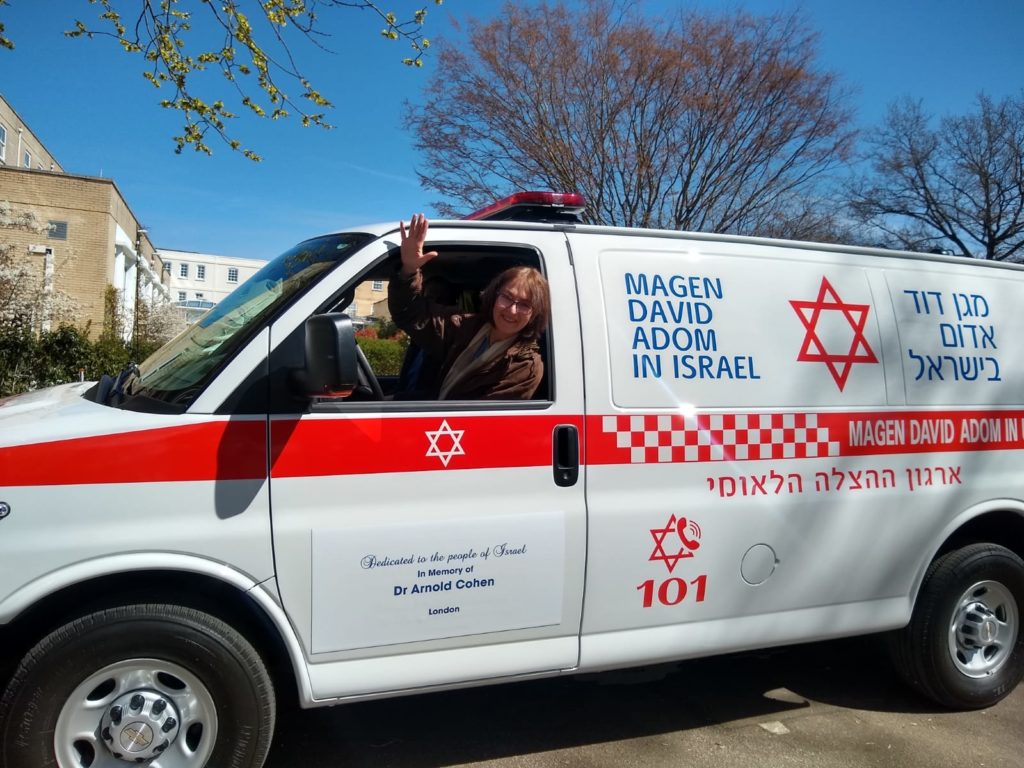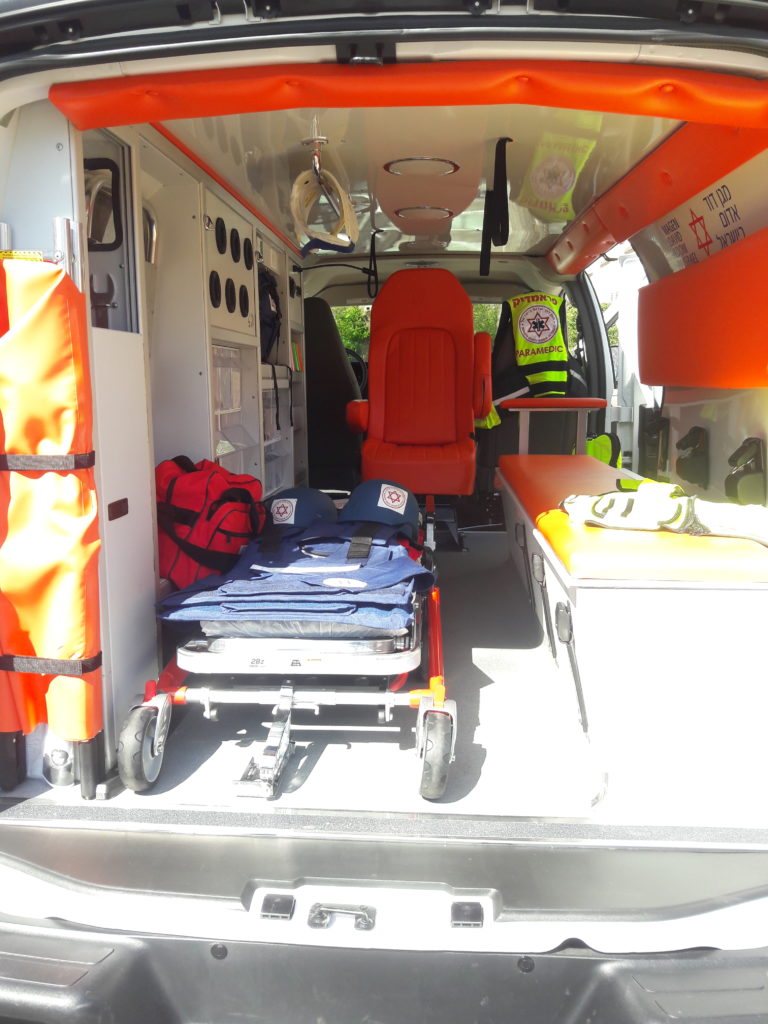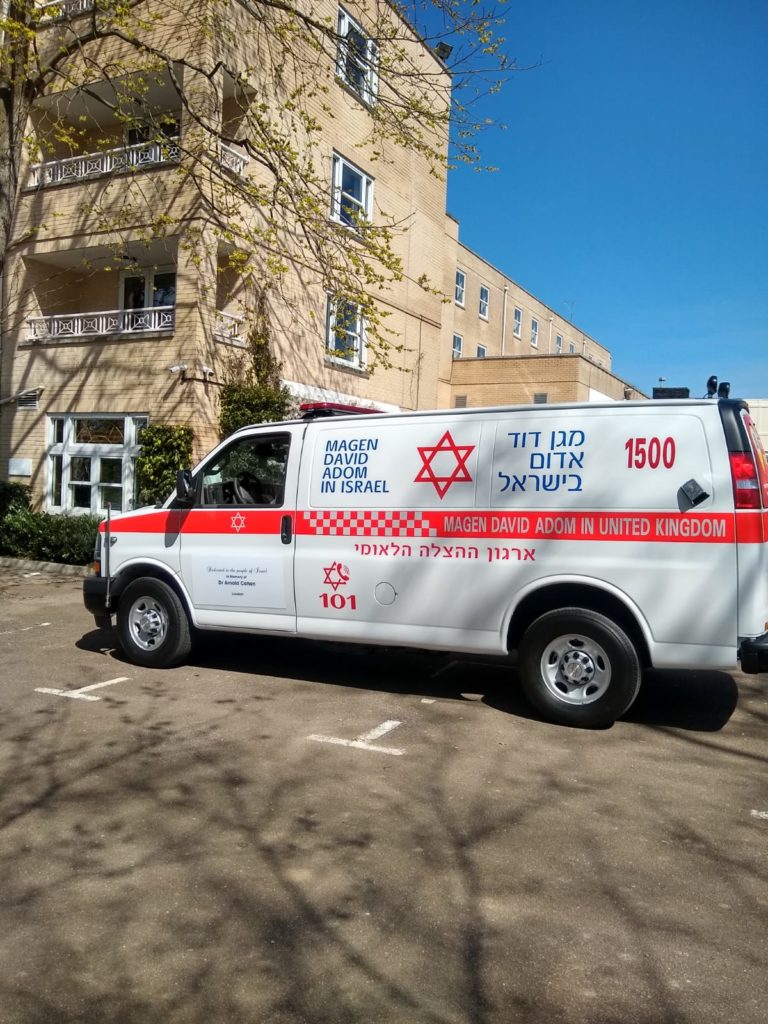Guest post by KLS member Hilary about the ambulance bequeathed to the charity by her late Uncle.
Recently, Magen David Adom (MDA) UK extended an invitation to my family to celebrate the dedication of a new ambulance – followed by lunch at Sopwell House, a hotel and reception venue (complete with spa) near St Albans. The ambulance was stationed in the car park and there were four representatives (and a photographer) from the Charity to meet us. But this was no ordinary ambulance. It was special because it was purchased using a legacy that my Uncle Arnold, who passed away last September, had bequeathed to the charity. (See the livery on the driver’s door).

To our amazement they offered to let us drive the ambulance around the car park. My sister and I jumped at the chance! So very slowly around the car park we went. I did look for the siren button, but for some reason couldn’t activate it, So it was a very quiet, but flashy drive…
We learnt that Israel has a fleet of about 800 ambulances, about 80 of which need replacing each year. When they are about 10 years old, they are retired/taken off the road. Although Israel will pay for the running costs of the vehicles and all the medical provisions within, it cannot afford the actual capital costs. So the vehicles are all donated by various organisations around the world including in Israel. The UK sends about 10 vehicles annually.
There are 2 kinds of ambulance in the fleet. About 200 are for more serious responses and are manned by fully trained and qualified paramedics – and sometimes doctors, if required. They are equipped with a higher level of equipment for the more serious cases and some medical procedures can be performed in the vehicle, even while it’s on the road (and moving). The one in which we rode was of a lower level, will not be manned by paramedics, and its prime purpose is to get the patient to hospital as quick as possible. It has room for two patients, at a squeeze.
Even though it is of the more simple type, it did still have a lot of equipment on board which was all collapsible and very compact. As you can see the whole vehicle is only the size of a medium van:

Israel has experimented with larger vehicles, but found they couldn’t manoeuvre through the narrow roads and streets.
We were also shown the bullet/stab vests and helmets which were a beautiful blue colour. We were told that Israel is the only country in the world where the whole team wear bullet and stab proof helmets and vests. Each ambulance also carries a stab/bullet vest for the patient.
MDA is manned primarily by volunteers – the only ones who are paid are the paramedics, so it is essentially a volunteer service. Paramedic training is very expensive, so they keep the numbers of paramedics low and only use them where necessary. All the emergency services are under central control (unlike ours, which are regional), so if you dial 101 for the ambulance, you get through to a central control board who dispatches the nearest vehicle. The ambulance we saw today is going to be stationed in Nazareth.
In another first, Israel has a very advanced reporting system to try to keep patients out of ER (A&E). The ambulance reports ahead with the type of injury they have on board and the appropriate department in the hospital is warned and primed to receive the patient, thus by-passing ER. They even allow patients to send pictures of themselves showing their injuries/predicaments/situations when calling for the ambulance to help decide the appropriate response. All this saves time and resources. The impression we were left with is that MDA is a highly sophisticated service. Apparently, the UK is currently in discussions with Israel with a view to bringing some of this process here.
For the nerdier amongst us, the vehicles are Chevrolet and made in the US. Each one is given a number (ours is 1500) and the technology on board relays to a central server all the details of the vehicle’s movements and keeps a history of all its cases. So in years to come, we’ll be able to look up our vehicle and see how many road accidents it attended, how many terrorist incidents, pregnant women, and even how many babies were born in the ambulance etc.

Finally, in case anyone is wondering, lunch was a lovely sandwich affair, with plates of ready cut fruit and cakes to follow, and plenty to drink, all consumed in wonderful sunshine outdoors at tables holding no more than 6 people and 2 households. The only unanswered question I have from today is – what would the spa be like? – definitely worth a return visit to find out!
